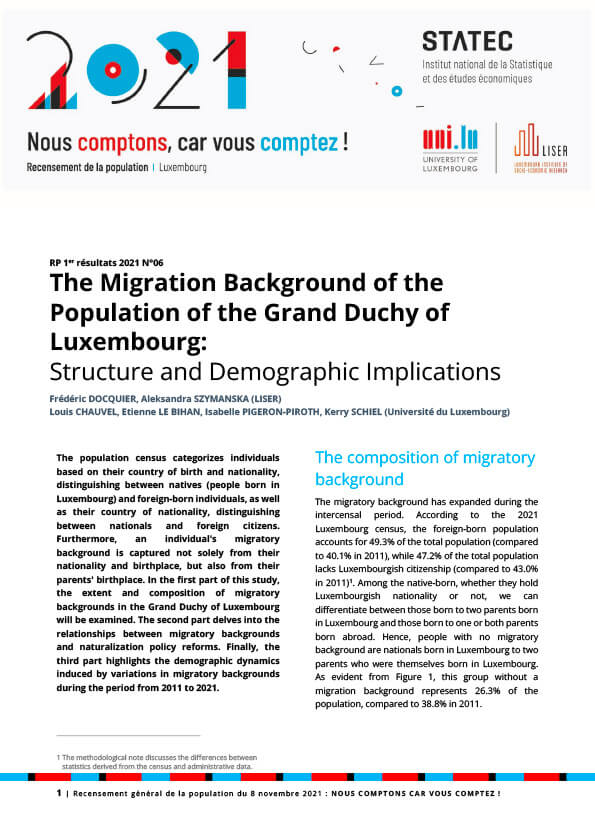The migration background
-
of Luxembourg's population has a migration past
73.7 %

Composition of migratory background
According to the 2021 Luxembourg census, the foreign-born population represents 49.3% of the population. On the basis of nationality, 47.2% of the population is non-Luxembourgish.
Among people born in Luxembourg, a distinction is made between those with two parents born in Luxembourg, and those with at least one parent born abroad and who therefore have an indirect migratory background. 26.3% of the population has no migratory link: these are Luxembourgers born in Luxembourg to two parents who were themselves born in Luxembourg. 73.7% of the population therefore has a direct or indirect migratory background.
Population by primary nationality and country of birth
Looking at the breakdown by nationality, during the 2021 census, 52.8% of those surveyed hold Luxembourg nationality, while 38.2% have a main nationality from another European Union member state. Among the latter, the most common foreign nationalities are Portuguese (14.5% of the population), followed by French (7.6%), Belgian (3.1%) and German (2.0%).Citizens of other European countries make up 2.7% of the population, while non-Europeans account for 6.3%.
Of the population, 44.1% are Luxembourgers born in Luxembourg, 5.1% were born in other European Union Member States, and 1.3% were born in other European countries. This means that only 2% of Luxembourg citizens were born outside Europe.
Migratory background and naturalizations
During the 2021 census, a total of 70,825 respondents indicated that they had obtained Luxembourg nationality through naturalization, representing 20.8% of the population with Luxembourg nationality.
The majority of these naturalized citizens, i.e. 50,205 people, acquired their nationality during the period 2002-2021. This period was marked by several reforms to the law on naturalization, demonstrating Luxembourg's commitment to inclusion and integration.
The 2017 reform, enacted in April of the same year, immediately led to an immediate increase in naturalization cases (see Figure 2). The number of people acquiring Luxembourg nationality rose by more than 50% in 2017 compared with 2016. Furthermore, the number of people obtaining Luxembourg nationality more than doubled in the following years, particularly in 2018 and 2019, compared with the figures from 2016.
Figure 2: Overview of self-reported annual Luxembourgish citizenship uptake
between 2002-2021.
Almost half of all naturalized Luxembourgers, or 44.1% of the total, were born in Luxembourg. The rest were mainly born in Portugal (8.3%), the countries of the former Yugoslavia (6.5%), France (6.1%), Belgium (5.3%) and Germany (5.1%).
A detailed look at the population of Luxembourg with multiple nationalities
Thanks to the 2008 reform, Luxembourgish citizens are no longer subject to restrictions on holding multiple nationalities. However, it is important to note that if a nationality has been withdrawn/abandoned in the past, naturalized citizens are not authorized to regain it.
In Luxembourg, 10.9% of the population holds several citizenships. Among residents, 10.5% have two nationalities, while 0.4% possess three or more.
Notably, 80.4% of foreign residents have the nationality of other European Union Member States, which allows them to stay in Luxembourg without a visa and to enjoy equal rights.
Demographic dynamics
Between 2011 and 2021, Luxembourg's migratory profile will have changed radically.
Three main population groups
A first group includes all individuals with at least one parent born in Luxembourg. Since they have ties to the country spanning at least two generations, they are called "2nd generation (2G) natives". In 2021, almost all 2G natives were themselves born in the country (96.6%) and held Luxembourgish nationality (99%). Group 1 has remained numerically stable from 2011 to 2021 (around 240,000 people), but as the total population has grown considerably, its relative weight has fallen from 46.7% in 2011 to 37.3% in 2021.
| 2011 | 2021 | Diff. | |
|---|---|---|---|
| "2nd generation natives": almost all are Luxembourg nationals |
239 228 | 240 251 | 1 023 |
| First-generation Luxembourgers L1G (national, but no parent born in the country) |
23 061 | 102 011 | 78 950 |
| Residents of foreign nationality | 250 064 | 301 679 | 51 615 |
| Total | 512 353 | 643 941 | 131 588 |
Table 1: The major components of the population of Luxembourg in 2011 and 2021
At the other end of the scale, another group includes "foreign residents" with no parent born in Luxembourg, i.e. all those surveyed who do not have Luxembourgish citizenship. This group has grown by almost 50,000, from 250 to 301,000.
The last group, located between the two previous groups, is made up of so-called "first-generation" Luxembourg citizens (L1G) who have no parents born in the country, but who have Luxembourgish nationality. In the space of a decade, this group has grown from 4.5% to 15.8% of the total population, more than tripling. The increase is even more spectacular in absolute terms, rising from 23,000 to 102,000, an increase of almost 79,000 people.
Over the period, the "2G natives" are numerically stable at around 240 thousand residents (+0.4%). Overall, in 2021, they will represent more than two-thirds of all Luxembourg citizens, compared with nine-tenths in 2011!
Figure 3: Details on the major components of the population of Luxembourg and their changes between 2011 and 2021
Migration background and age dynamics
These overall changes in the population interact with age classes, in connection with the ageing of individuals and social groups, as well as migration, resulting in significant changes in the age pyramid.
Figure 4: Age distribution (combined for men and women), and population dynamics of Luxembourg 2011-2021
The shape of this pyramid Luxembourg's diamond-shaped pyramid is the result of the migratory composition of the workforce and the effects of ageing: the high proportion of residents among the working population is largely the result of the country's migratory past and recent changes.
Many foreigners aged between 20 and 50 come to live and work in Luxembourg, settling with their children or unborn children, many of whom are destined to acquire Luxembourg nationality quickly. As a result of the ageing effect from one census to the next, the number of foreigners in their fifties and sixties subsequently increases, giving rise today to a diamond shape, which should continue to evolve in subsequent censuses, depending on several parameters such as ageing, the birth rate and the migratory balance.
Find out more about the migratory background in Luxembourg

More results
In the coming months, various publications will be produced for the public, but also for the public specialised in demographic issues. At the same time, statistical tables on the various census topics will be published on the Statistics Portal.
Why is the census important?
Census results are essential information for public policy decision-making.
Census data help to forecast needs for land use planning, schools, nurseries, hospitals, retirement and nursing homes, housing, etc.
Last update

